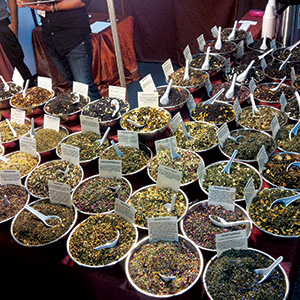Cupertino’s Don Sun is the CEO of Sierra Tea in Santa Clara. His company is the U.S. importer for Hunan Tea Company, an industry leader in China whose annual sales are about 40,000 tons. A few weeks ago at the World Tea Expo in Long Beach, I cornered him on the expo floor, in Sierra Tea’s booth, and immediately failed to impress him with my knowledge of pu’erh tea.
After hearing about my penchant for the ultra-dark, earthy stuff and its tendency to relay ancient transmissions from cave-dwelling Taoist hermits, he said pu’erh was starting to lose popularity in China. Black tea is on the rise there, he explained. I was disappointed.
The World Tea Expo unfolded over three days. It was not open to the general public, but rather an event for industry professionals, importers, exporters, organic tea farm enthusiasts, SoCal teashop fashionista hotties and eccentric characters in linen suits straight from Graham Greene novels. There were Indian, Chinese, Nepalese, French-Canadian, Korean and Sri Lankan contingents. High society birds, porcelain aficionados, packaging entrepreneurs and young aspiring organic farmers alike all seemed to exude a particular quivering euphoria for the Camellia sinensis plant. I made many new acquaintances and invited myself to people’s plantations in Kenya, Malawi and South Africa.
Since the exposition was the premier affair of its kind anywhere on Earth, there were books, pamphlets, machinery, receptacles, accessories, catalogs and designer tea bags—all for industry folk to peruse and/or purchase. Bowls and bowls and bowls of tea samples displayed themselves with museum-like savoir faire. Zillions of leaves were steeped for all to sample. Since I was the only member of the media from anywhere in Silicon Valley, I feel inclined to rattle off in Tolstoyian extremes the sheer volume of manifestations and crystallizations I slurped with gusto: Japanese Sencha, Turmeric Ginger Rooibos, Vanilla Lemongrass, Egyptian Chamomile, Blueberry Tranquility, Witch’s Broom, Exotic Vacation, Peace King Monkey, Yellow Mountain Silver Needle, Iron Silk and Kenya Estate Black.
As a result, I became a transdimensional blend of Buddhist monkey and Anglican royalty. Over three days, I went from booth to booth, steep to steep, explaining to peep after peep how I write travel narratives incorporating alchemical principles and Jungian psychology, creatively fusing the Western and Eastern halves of myself via the ancient cosmic muse of tea, and how its quantum aspects can, theoretically and practically, channel both Tang Dynasty hermits and high society British aristocracy. Nobody seemed to understand what the hell I was saying.
Nobody except for James Norwood Pratt, of course. He seemed to know exactly what I was talking about. Pratt is America’s reigning tea sage who has perhaps done more to bridge East and West when it comes to tea than anyone I can imagine. It was he that penned the introduction to Scott Hoyt and Phil Cousineau’s space-time continuum-clobbering assemblage of esoteric tracts, The Soul & Spirit of Tea, which I just ingested a few months ago.
Pratt, a decades-long resident of San Francisco, particularly Chinatown, lectured at the expo, discussing the basic differences between green tea, black tea and oolong. If you’re confused, look at it this way: green tea is unfermented, while black tea is fermented. Somewhere on the continuum between those two, one finds oolong, the varieties of which come in differing degrees of fermentation. The Chinese have terms like “jade oolong” for the types of oolong closest on the continuum to green tea, and “amber oolong” for those blends closer to black tea. These days, industry hipsters tend to use the word “oxidized” rather than “fermented,” so you’ll hear things like “semi-oxidized oolong,” which just means it’s semi-fermented. Jade and amber are loose versions of Chinese image-ideas that can’t be translated. Pratt also said a Chinese expert often refers to his favorite tea as his “monkey pick” due to an ancient story that only monkeys could physically pick the most unreachable leaves. That is pure poetry.
Pratt’s enlightening demonstration further relayed the ancient transmission and I felt even more connected to those Taoist hermits. I will have to visit Sierra Tea in Santa Clara and get the real lowdown on Pu’erh.




